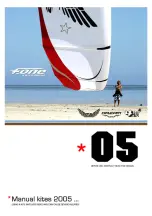
SECTION 5: GENERAL INFORMATION
CAUTION: When spray painting ANY primer, work in a well ventilated area and wear, at the very least, a UL approved
respirator with carbon filters. Systems providing fresh filtered air have become more affordable in the last few years and
provide the operator a superior level of comfort and safety. As the name "Metal Etching Primer'' implies, the catalyst
component contains an acid which can be dangerous if breathed. Similar precautions must be taken for spraying any of
the two-part primers and paints. Check with the paint supplier for exact precautions required.
Primers like P60G2, Vari-Prime and others are relatively inexpensive, light and easy to apply. These characteristics make them
appeal to many builders. They do need to be sprayed with a gun, which is awkward for some, but the pain can be minimized if you
prepare large batches of parts to reduce set up and clean up time.
Some aerosol primers are useful for small parts when you don't want to set up to spray a whole batch. Usually there will not be a
problem with mixing and matching the type of primers used, but we do not know for sure. They are impractical for painting the
whole airplane or large skins.
Though some disagree it is generally accepted that two-part epoxy primers provide the best corrosion resistance. However, they
are expensive, toxic, heavy and dry slowly making them problematic for the home builder. If one can tolerate these issues and
desires an RV that would be in good shape for grandchildren to inherit then two-part epoxy primers may be the "best" solution.
Van's Aircraft does not have an "approved" primer. We use Sherwin Williams P60G2. This is used on the Quick-Builds (QBs) and
prototypes made here. The QB's primer has no pigment so it just makes the interior surfaces slightly darker and less shiny. In the
US, this primer has a green tint so the two will not match exactly. We use this primer because it is inexpensive, dries fast, and is
easy to apply. Sherwin Williams will tell you that the primer needs a top coat. While this is true for optimum corrosion resistance we
feel that this is not necessary for the way in which most owners will maintain their RVs.
Whatever you use, prepare the surface as per the manufacturer's instructions. This can be as simple as washing with water or as
complex as acid etching and alodining. We have nothing to add to whatever they may advise.
NOTE: Plans pages may refer to Section 5 by a letter designation. Please refer to the conversion chart below to find the corresponding section's numerical designation.
# LETTER
5.1
5A
ALUMINUM PRIMING & PAINTING
5.2
5B
EDGE FINISHING, DEBURRING & SCRATCH REMOVAL
5.3
5C
MARKING PARTS
5.4
5D
RIVETING
5.5
5E
COUNTERSINKING & DIMPLING
5.6
5F
BACK RIVETING
5.7
5G
FOLDED TRAILING EDGES
5.7
5H
RIVETED TRAILING EDGES
5.9
5J
ROLLED LEADING EDGES
5.10
5K
LAP JOINTS
# LETTER
5.11
5L
FORMING ALUMINUM PARTS FROM SHEET
5.12
5M
VINYL COATING
5.13
5N
FLUTING
5.14
5P
ALUMINUM TUBING
5.15
5Q
STEEL
5.16
5R
INSTALLING NUTPLATES
5.17
5S
FUEL TANK SEALANT
5.18
5T
FIBERGLASS
5.19
5U
ACRYLIC CANOPY & Lexan WINDOWS
5.20
5V
NUT & BOLT TORQUES
NOTE: This section is not intended to be a complete manual on aircraft construction. Supplement this information with
some of the publications listed in Section 1.
5.1 ALUMINUM PRIMING & PAINTING
The aluminum skins used on RV aircraft are all 2024-T3 alloy. They are "alclad", meaning that both sides of the sheet are coated at
the mill with pure aluminum. This forms aluminum oxide, a corrosion resistant material which need not be primed or painted for
adequate service as an airframe material. However, if the airplane is to be kept in a salt-air environment, or if a greater margin of
corrosion protection is desired, priming the entire inside of the airframe is a good idea. Remember that priming will add cost, weight
and time to your project.
WARNING: When installing threaded fittings/rod ends into primed tube be sure that the primer has cured fully. Failure to do
so could result in seized bearings.
All non-alclad aluminum parts such as 6061-T6 must be primed. Control System Pushrods must be primed both inside and out. (Do
not prime inside of fuel or brake lines.)
To prime the inside of pushrods with liquid primer, pour primer into one end and swirl it towards the other end, coating the entire
inside surface. Alternatively, spray primer into one end of the pushrod, turn the pushrod around and spray again from the other end.
The majority of the parts in the kit have been coated in our plant with vinyl to protect them during manufacturing. We suggest that
you remove the vinyl as soon as practical after inventorying your kit. (See 5.12) The pre-assembled spars are anodized and need no
additional protection.
All aluminum bar, angle, and tube used is
not alclad and must be primed to assure
corrosion resistance. The traditional
primer used on aircraft aluminum has
been Zinc Chromate. With proper surface
cleaning, this is still a good primer.
However, there are many newer primers
available which are superior. Most of
these are two-part, catalytic curing primers.
# LETTER
5.21
5W
ELECTRICAL
5.22
5X
COMPRESSION FITTINGS
5.23
5Y
NYLON FLUID FITTINGS
5.24
5Z
DRILLING, TAPS & DIES
5.25
---
DIMENSIONS
5.26
---
HARDWARE REFERENCE
5.27 ---
FLUID FITTINGS
5.28
---
CONCLUSION
PAGE
REVISION:
DATE:
VAN'S AIRCRAFT, INC.
05-01
RV-ALL
1
07/17/14
Brand
Product
DITZLER -
DP-40/50 EPOXY PRIMER
DUPONT-
VERI-PRIME (PRIMER #615 and CONVERTER #616S)
MARHYDE -
Self-etching primer, available in a spray can as well as quarts
PRATT & LAMBERT -
Vinyl Zinc Chromate, EX-ER-7 and T-ER-4 Reducer
TEMPO -
Chromate in a spray can
SHERWIN WILLIAMS - WASH PRIMER #P60G2 and Catalyst Reducer #R7K44
















































